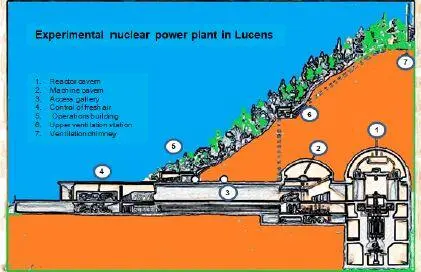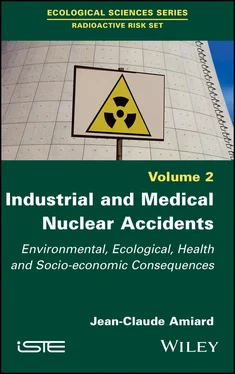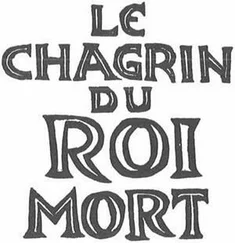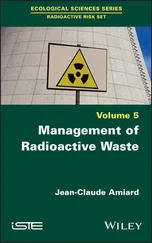1 ...6 7 8 10 11 12 ...17 In France, the first stages of the fuel cycle are not immune to accidents, and radioactive releases into the environment are not always negligible. This was the case at the Pierrelatte (Comurhex) plant in 1977 (January 1 and November 25) where several tons of uranium hexafluoride leaked into the atmosphere without apparently contaminating the soil away from the plant site. A 30 m 3leak of a solution containing 74 kg of uranium occurred on July 9, 2008 in a plant at the Tricastin nuclear site in Bollène (Vaucluse), part of which spilled into surrounding rivers [AMI 13a].
The largest use of nuclear energy is in the production of electricity. This is the area with the highest number of accidents. Table 2.1 lists accidents classified as severe on the INES with a rating of 3 or more. Subsequently, the three most serious civil accidents (Three Mile Island, Chernobyl and Fukushima Daiichi) will be detailed.
Table 2.1. The most significant accidents that have occurred in civil nuclear installations. G: severity on the INES
| G |
Date |
Site, country |
Type of installation (number of years) |
Type of accident |
| 3 |
06/01/1981 |
La Hague, France |
Reprocessing plant (15 years) |
Fire in a storage silo |
| 16/08/1989 |
Gravelines, France |
PWR reactor (9 years) |
Inadequate screw in the primary circuit’s valve |
| 19/10/1989 |
Vandellos, Spain |
Gas-graphite reactor (17 years) |
Fire of a turbo alternator unit |
| 11/03/1997 |
Tokai-Mura, Japan |
Fuel production plant (18 years) |
Fire and explosion irradiating 37 people |
| 10/04/2003 |
Paks, Hungary |
PWR reactor (19 years) |
Radioactive leakage in the fuel rod cleaning system |
| 21/04/2005 |
THORP/Sellafield, United Kingdom |
Reprocessing plant (8 years) |
Leakage of radioactive liquid following a ruptured pipe |
| 4 |
21/01/1969 |
Lucens, Switzerland |
Heavy water reactor (1 year) |
Cooling failure resulting in partial fusion of the reactor |
| 17/10/1969 |
Saint-Laurent-des-Eaux, France |
Gas-graphite reactor (1 year) |
Uranium smelting Reactor shutdown for 1 year |
| 26/09/1973 |
Windscale/Sellafield, United Kingdom |
Reprocessing plant (22 years) |
Explosion and release of radioactive materials (37 people irradiated) |
| 07/12/1975 |
Lubmin, Germany |
PWR reactor (1 year) |
Short circuit on the reactor transformer, fire and destruction of cooling pump supply |
| 22/02/1977 |
Bohunice, Slovakia |
Gas-cooled heavy water reactor (5 years) |
Core corrosion and power failure during fuel changeover |
| 13/03/1980 |
Saint-Laurent-des-Eaux, France |
Gas-graphite reactor (9 years) |
Uranium melting and damaged core (corrosion) |
| 30/09/1999 |
Tokai-Mura, Japan |
Fuel fabrication plant (22 years) |
Uranium dosing error and explosion (three irradiated, two deaths) |
| 5 |
10/10/1957 |
Windscale |
Military reactor (11 years) |
Fire |
|
28/03/1979 |
Three Mile Island, United States |
PWR reactor (1 year) |
Partial fusion of the reactor core |
| 6 |
1957 |
Kyshtym, USSR |
Reprocessing plant (?) |
Explosion (>10 PBq 131I) |
| 7 |
26/04/1986 |
Chernobyl, USSR (Ukraine) |
Pressure tube reactor (3 years) |
Explosion and partial melting of the core |
| 11/03/2011 |
Fukushima-Daiichi, Japan |
BWR reactors (36–40 years old) |
Cooling shutdown and partial core melting of three reactors |
2.2.3.1. Accident at the Simi Valley nuclear power plant
The Santa Susana Field Laboratory (SSFL) was a test site used for rockets and nuclear reactors, located 40 km from the geographical center of the Los Angeles metropolitan area (California), near Simi Valley.
On July 26, 1959, during the 14th low-power test of the Sodium Reactor Experiment (SRE), following a poor sodium flow, the temperature difference between the various fuel channels was found to be excessively high. After the immediate termination of this test, it appeared that 13 of the 43 fuel elements were damaged [ASH 59, ASH 61].
The Simi Valley accident has remained relatively unknown and continues to be shrouded in mystery today. As a result of corporate and government secrecy, news of the incident came only 20 years later, and the information provided is few and far between [ROG 12].
Thus, while Ashley et al . [ASH 59] claim that no radiological hazards were present in the vicinity of the reactor, subsequent information would estimate radioactive releases 240 times higher than those from Three Mile Island [GRO 15]. Similarly, a controversy over iodine 131 releases arose between those who claimed that no iodine releases had occurred as a result of the accident [CHR 05, DAN 05] and those who believed that substantial quantities of iodine had been released into the atmosphere [MAK 05, MAK 06, LEL 12].
Iodine 131 releases were estimated at 1,300 Ci (4.81.10 13Bq) by Makhijani [MAK 06]. According to Lelieveld et al . [LEL 12], the radioactive releases from this accident were greater than 200 PBq (without taking into account the supposed substantial emissions of 85Kr and 133Xe but without any available data), making this accident one of the most serious, at level 5 or 6 on the INES. Based on the damaged reactor core fraction (30%), the analytical value of the radioactive iodine and cesium fraction released by the damaged fuel (10%) and an empirical value of the efficiency of the ventilation system (10%), Lochbaum [LOC 06] concluded that the fraction of the total cesium inventory in the SRE reactor core at the time of the July 1959 accident reaching the environment was between 0.3% and 30% and the fraction released of radioactive iodine was between 3% and 30%. This author estimated that the 15% value for the amount of iodine released was the most likely.
2.2.3.2. Accident at the Lucens nuclear power plant
Construction of a heavy water reactor at the Lucens site in Switzerland began in 1962 (Figure 2.3). It was constructed completely underground, with the exception of a few storage and operations buildings. At the beginning of 1969, after a period of revision, the Lucens power plant reactor was returned to service. On January 21, 1969, when the power was increasing, the pressure in the primary cooling system dropped sharply. The instruments also reported a significant increase in radioactivity in the facility enclosure and a significant loss of heavy water. This meant that the moderator tank was damaged. An emergency shutdown of the reactor was carried out, and the caverns were isolated from the outside by closing the ventilation ducts. A few hours after the accident, radioactivity in the access tunnel decreased and the reactor continued to be cooled. Measurements taken on the night of the accident itself, and subsequently, showed that the level of radioactivity in the vicinity had hardly changed from a background level. After this incident, the facility was completely dismantled and the caverns decontaminated. The dismantling work, the decontamination, the analyses of the causes of the accident, the various expert reports and the publication of the final report took more than 10 years [CAN 11].

Читать дальше













